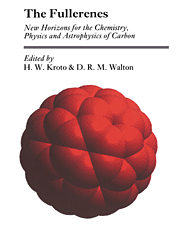Book contents
- Frontmatter
- Contents
- The evolution of the football structure for the C60 molecule: a retrospective
- Dreams in a charcoal fire: predictions about giant fullerenes and graphite nanotubes
- On the formation of the fullerenes
- Production and discovery of fullerites: new forms of crystalline carbon
- Systematics of fullerenes and related clusters
- The fullerenes: powerful carbon-based electron acceptors
- The carbon-bearing material in the outflows from luminous carbon-rich stars
- Elemental carbon as interstellar dust
- The pattern of additions to fullerenes
- Pollyynes and the formation of fullerenes
- Hypothetical graphite structures with negative gaussian curvature
- Fullerenes as an example of basic research in industry
- Deltahedral views of fullerene polymorphism
- Geodesic domes and fullerenes
Geodesic domes and fullerenes
Published online by Cambridge University Press: 03 February 2010
- Frontmatter
- Contents
- The evolution of the football structure for the C60 molecule: a retrospective
- Dreams in a charcoal fire: predictions about giant fullerenes and graphite nanotubes
- On the formation of the fullerenes
- Production and discovery of fullerites: new forms of crystalline carbon
- Systematics of fullerenes and related clusters
- The fullerenes: powerful carbon-based electron acceptors
- The carbon-bearing material in the outflows from luminous carbon-rich stars
- Elemental carbon as interstellar dust
- The pattern of additions to fullerenes
- Pollyynes and the formation of fullerenes
- Hypothetical graphite structures with negative gaussian curvature
- Fullerenes as an example of basic research in industry
- Deltahedral views of fullerene polymorphism
- Geodesic domes and fullerenes
Summary
The structural form of geodesic domes, composed of pentagons and hexagons, played an important role in understanding the structure of carbon clusters. In this paper an analogy between geodesic domes and fullerenes is investigated. A brief survey is given of the geometry of geodesic domes applied in engineering practice, in particular of the geodesic domes bounded by pentagons and hexagons. A connection is also made between these sorts of geodesic domes and the mathematical problem of the determination of the smallest diameter of n equal circles by which the surface of a sphere can be covered without gaps. It is shown that the conjectured solutions to the sphere-covering problem provide topologically the same configurations as fullerene polyhedra for some values of n. Mechanical models of fullerenes, composed of equal rigid nodes and equal elastic bars are also investigated, and the equilibrium shapes of the space frames that model C28, C60 and C240 are presented.
Introduction
From visual inspection one can easily discover an analogy between the structure of C60 and the inner layer of the structure of the great U.S. pavilion of R. B. Fuller at the 1967 Montreal Expo. This analogy and other geodesic structures of Fuller were responsible for the name of C60: Buckminsterfullerene (Kroto et al. 1985). This is not the first time that Fuller's geodesic domes have helped researchers to understand the structure of matter. In the early 1960s Fuller's geodesic domes, especially his tensegrity spheres, inspired Caspar & Klug (1962) to develop the principle of quasiequivalence in virus research.
- Type
- Chapter
- Information
- The FullerenesNew Horizons for the Chemistry, Physics and Astrophysics of Carbon, pp. 145 - 154Publisher: Cambridge University PressPrint publication year: 1993



